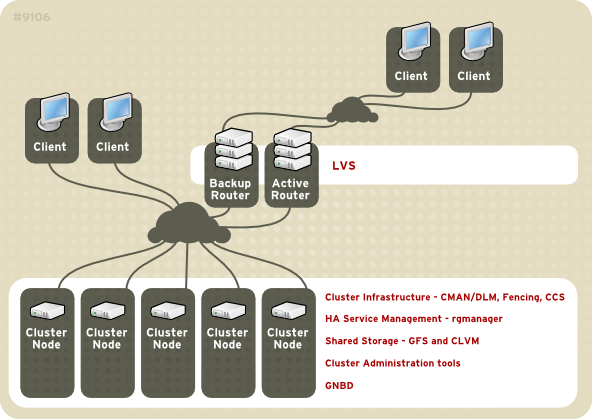1.2. Red Hat Cluster Suite Introduction
Red Hat Cluster Suite (RHCS) is an integrated set of software components that can be deployed in a variety of configurations to suit your needs for performance, high-availability, load balancing, scalability, file sharing, and economy.
RHCS consists of the following major components (refer to Figure 1.1, “Red Hat Cluster Suite Introduction”):
- Cluster infrastructure — Provides fundamental functions for nodes to work together as a cluster: configuration-file management, membership management, lock management, and fencing.
- High-availability Service Management — Provides failover of services from one cluster node to another in case a node becomes inoperative.
- Cluster administration tools — Configuration and management tools for setting up, configuring, and managing a Red Hat cluster. The tools are for use with the Cluster Infrastructure components, the High-availability and Service Management components, and storage.
- Linux Virtual Server (LVS) — Routing software that provides IP-Load-balancing. LVS runs in a pair of redundant servers that distributes client requests evenly to real servers that are behind the LVS servers.
You can supplement Red Hat Cluster Suite with the following components, which are part of an optional package (and not part of Red Hat Cluster Suite):
- GFS — GFS (Global File System) or GFS2 (Global File System 2) provides a cluster file system for use with Red Hat Cluster Suite. GFS/GFS2 allows multiple nodes to share storage at a block level as if the storage were connected locally to each cluster node.
- Cluster Logical Volume Manager (CLVM) — Provides volume management of cluster storage.
Note
When you create or modify a CLVM volume for a clustered environment, you must ensure that you are running theclvmddaemon. For further information, refer to Section 1.6, “Cluster Logical Volume Manager”. - Global Network Block Device (GNBD) — An ancillary component of GFS/GFS2 that exports block-level storage to Ethernet. This is an economical way to make block-level storage available to GFS/GFS2.
Note
Only single site clusters are fully supported at this time. Clusters spread across multiple physical locations are not formally supported. For more details and to discuss multi-site clusters, please speak to your Red Hat sales or support representative.
For a lower level summary of Red Hat Cluster Suite components and optional software, refer to Chapter 2, Red Hat Cluster Suite Component Summary.
Figure 1.1. Red Hat Cluster Suite Introduction
Note
Figure 1.1, “Red Hat Cluster Suite Introduction” includes GFS, CLVM, and GNBD, which are components that are part of an optional package and not part of Red Hat Cluster Suite.
